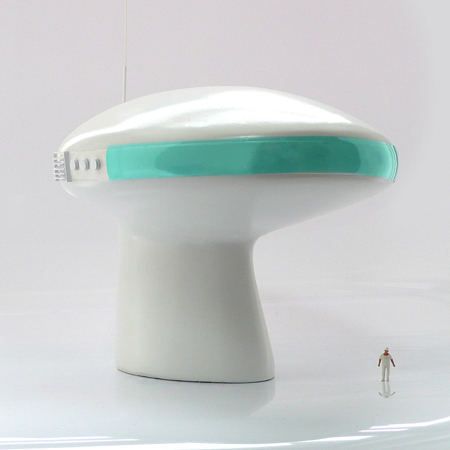Reboot is a conceptual house designed by Victor Vetterlein to be completely self-sufficient.
The pod-like house makes use of solar cell paint, wind turbines and rainwater collection to harvest energy.
The internal environment is digitally controlled and operated by voice activated sensors, remote controls and touch pads or remotely from a mobile phone or computer.
More from Victor Vetterlein on Dezeen:
Meeraboo FL-1
Meeraboo ST-1 and G-Force
Here's some more information about Reboot from Vetterlein:
--
Introducing ‘Reboot’, a POD house by Victor Vetterlein.
Reboot is designed to be self-sufficient, wired, and fluid in form.
RPOD050108_Self-Sufficient
Reboot is self-sufficient and eco-friendly. The building is constructed with a space frame, and the outer skin increases structural strength through double curvature. The skin system consists of a vapor barrier, dense foam insulation, and metal sheathing where the exterior face is glazed in solar cell paint. The surface of the building serves as a solar energy collector.
Supplemental electricity is provided by on-site wind turbines and energy is stored in batteries on Deck 1. Wind power is also used to pressurize a large canister to operate the hydraulic elevator and the water treatment system. The smooth outer skin of the building acts as a foil against adverse weather conditions, and the rooftop serves as a water collection surface where rainwater runs into a drain located above the resin laminated glass windows. The water is stored in holding tanks positioned below the Main Deck and managed by an in-house water treatment system on Deck 2.
Natural ventilation is provided by operable vents located at the top and the bottom of the structure. Lastly, the building’s mechanical systems are stacked on two floors above the Ground level eliminating the need for massive ground penetrations and a large site footprint.
RPOD050108_Wired
Reboot is computer operated, fully automated, and wired to the max. The household living environment is managed by a direct digital control (DDC) system that oversees support networks such as lighting, heating, cooling, music, entertainment, and security. The user operates this system through voice activated sensors, remote controls, and touch pads.
The DDC system is accessed and controlled any distance from the dwelling via a laptop computer or a cell phone. Skylight covers, fresh air vents, retractable media screens, and retractable partition walls are also operated by the DDC system. Doors throughout the building are pocket doors and operated with motion or voice sensors. A main computer room on Deck 1 directs the DDC system, and an on-site satellite dish connects the house with the outside world.
RPOD050108_Fluid Form
Reboot’s floor plan is void of hard edges and fluid in form. Upon entering the building at the Ground level, one sees an elliptical glass elevator shaft that refracts natural light from the skylight above. A white stairway with a glass handrail encircles the elevator, winds upwards through two support service decks, and arrives at the primary living area on the Main Deck.
A hallway with walls covered in a white acoustical meshing leads to the Bridge with a panoramic exterior view as its terminus. The high gloss white floors and arched ceiling of the Bridge reflects light from the exterior scenery and amplifies the radiance of colors.
Public functions are in the front of the building, moderately public functions in the middle and private activities in the rear where there are two sleeping cabins. A panelized floor and wall system allows for a changeable floor plan for future living adjustments.
Reboot is more than a proposal for a private residence. The design of Reboot incorporates twenty-first century advancements in computer aided design and construction, building science and technology, and environmental awareness and energy independence.

